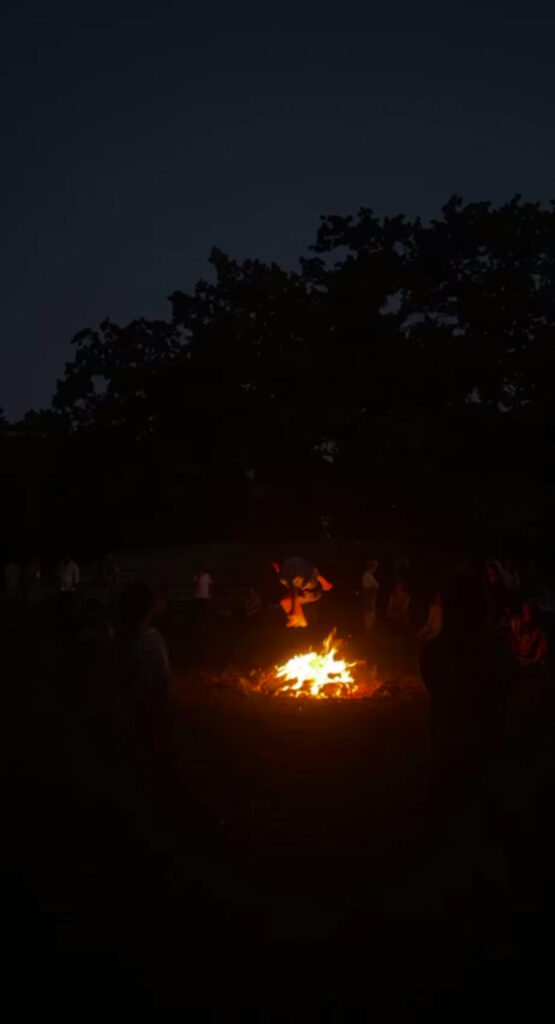At the midpoint of a particularly significant year for the Anthroposophic Society, while deep in contemplation over his time as a student at the Goetheanum, Ezra Sullivan receives a profound gift.
For five days, from the evening of the summer solstice through St. John’s Day weekend, a group of fifty Youth Section coworkers gathered at the Goetheanum. This marks the beginning of a new era for the Youth Section under the leadership of Nathaniel Williams. The gathering was a call for young people working in Anthroposophy to find a future together. I received just such a future calling. For me, it was the fruit of the gathering and I am taking it as deep inspiration leading to the 100th anniversary of the refounding of the Anthroposophical Society at the Christmas Conference of 1923.
The opening night of the gathering, held on the summer solstice, coincided with the final presentations and graduation of my cohort in the Foundation Studies year at the Goetheanum. A closing such as this one can suddenly thrust open a door, sometimes too forcefully, to that which will come from the future. The culmination of my study year had me in a deeply contemplative mood, reflecting on the study program as a whole, my time in Dornach, and the state of the Anthroposophical Society. When I think back on it now, this moment of inner inquiry had prepared me to enter the St. John’s events with an extra eye, open for receiving.
Interestingly, the Youth Section gathering coincided with a St. John’s conference hosted by the General Section. These two events were hosted at the same time and had roughly the same number of attendees: two starkly different groups going through St. John’s Day “together” at the Goetheanum. The youth gathering was comprised of young people while the St. John’s conference attendees were much older; the youth gathering was highly multicultural, and thus held entirely in English, whereas the General Section’s conference was almost exclusively in German.
As the youth gathering closed its final session on the night before St. John’s Day, a massive thunderstorm broke out with violent gusts of wind and an intense downpour of hard rain. This kept us socializing in our shelter on top of the hill, as we waited for better weather before descending to the Youth Section for dinner.

After the storm passed, we set out, hearts aflutter in the high summer mood of social and cultural exchange. Then we saw it: a tree down. A massive trunk of the scarlet beech tree that stands off the southwest corner of the carpentry shop above the Goetheanum had broken off. It had fallen perfectly, striking only one millimeter of the bench that sat beneath it. From there, we peered downhill to the Felsli.
The Felsli is a piece of landscape art in the open field southwest of the Goetheanum. It plays an important role in the landscape. The Goetheanum and Haus Duldeck sit on a ridge that runs east to west, extending out from the main ridge, which runs north to south, down into the valley below. The Felsli sits on the furthermost tip of the east-west ridge, looking out over the valley below to the west, the last point of movement through this landscape. It is a movement that begins with Haus Shuurman, peaks at the Goetheanum, passes by Haus Duldeck, and finally culminates at the Felsli.
“Landscape art” is too academic of a label for the Felsli—it’s a shrine, made of earth and stone. So much more could be said about the Felsli, but I will stay with the two linden trees planted at its center and the oak off to the side, which were standing at the time of the first Goetheanum. I believe the oak was already mature, and the two lindens were planted together about 120 years ago. One linden grew faster and overshadowed the other.
I’d heard a special story during my study year: lindens are a St. John’s tree. The story tells that at midsummer, St. John was sad as the farmers scythed the pastures for winter animal feed because the bees and other pollen-seeking critters would want for food. At midsummer, most of the trees and shrubs have already finished flowering, and with the meadows mowed, what would the bees eat? Jesus then gave the linden tree the most magnificent flowers, full of effervescent pollen, which open in their fullest bounty around St. John’s day. The Felsli linden trees were at the height of their flowering glory! When the linden is in flower, the whole crown becomes alive, vibrating with the movement, heat, and sound of bees and accompanied by the sweetest smell. This linden tree, at the center of the Felsli, stood at the height of its rhythm of expansion into the cosmos, absolutely ecstatic in its great offering, with a healthy crown full of lush green leaves and flowers.

And, like the scarlet beech, it fell during the momentous St. John’s thunderstorm. The Youth Section coworkers were some of the very first to come across it, along with the Goetheanum caretakers. Despite its lush appearance, the tree was not healthy. It had rotted nearly all the way through! The entire center was soft and decayed from fungus and only the cambium, or inner bark, was alive. Although I had spent much time at the Felsli, I had never noticed that this linden tree in the center branched into three separate trunks about 12 feet above the ground. All three trunks, a trinity, had fallen towards the Goetheanum, a St. John’s Day offering.
The timing of this offering is meaningful. In 2023, we are living through the 100th anniversary of the most significant year for the history of the Anthroposophical Society. 1923 began with the destruction of an initiation temple, the first Goetheanum, and ended with the refounding of the Society, to my mind Rudolf Steiner’s single greatest deed. When, at the middle point between the anniversaries of these two great events, a tree at the center of a sacred shrine falls at the steps of the Goetheanum, I take note. As I live through this year with an engaged heart, these potent and explicit symbols have come to meet me: the spiritual striving of the youth, the devotion of the ageing membership, St. John, the wind, the rain, the linden flowers, and the rotten heartwood.
As we face internal division, persecution, financial hardship, and a crisis of leadership, we might see Rudolf Steiner standing amidst the ashes of the first Goetheanum, in a deep, open inquiry into the future of the Society, and follow his journey, the Society’s journey, as well as our own journeys through the year toward the resolution to refound the Society. To begin again–it’s a trial, a task, an open question. Can we be refounded? Can we renew?
May we allow this year,
To shake us to the core.
This is a true calling.
Honouring the old,
As it crumbles to the ground.
Death becomes life.
Starting with the heart,
New growth can begin.
The rest will indeed follow.
Title image Felsli and the broken tree after the storm. Photo: Xue Li













